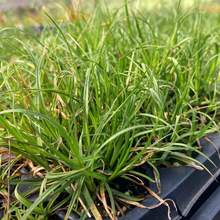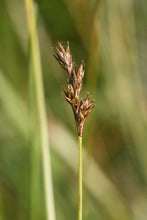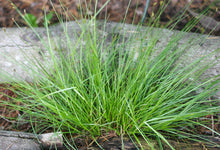Carex tumulicola
This native sedge, with grass-like foliage, has become a popular component of modern native landscapes due to its manageable size and versatility. Unlike most other native sedges, it is not a wetland plant so it thrives and looks great just about anywhere you plant it. It’s evergreen, drought-tolerant and the mounding foliage provides excellent habitat for arthropods.
- Plant type/canopy layer: evergreen, perennial, herbaceous plant
- Size at maturity: 8" tall, 18" wide
- Light requirements: full sun, part sun/part shade
- Moisture requirements: dry to moist soil
- Bloom time: n/a
- Growth rate/ease: medium growth rate, easy to grow
- Wildlife support: foliage provides nesting/refugia habitat for arthropods; seeds are eaten by songbirds; overall plant attracts and supports beneficial and pest eating insects and is a caterpillar host plant and larval food source for native moths and butterflies
- Native habitat/range: grows in grasslands, oak savanna, dry slopes, and forest openings, up to 800m, west of the Cascades from northern California to British Columbia. Portland Plant List - yes.
- Special features & uses: drought tolerant; deer resistant; evergreen
Gardening with Foothill Sedge: Perhaps the best thing about foothill sedge is that it’s one of the least-fussy plants out there when it comes to light exposure all-around soil type; acidity, moisture content, consistency or nutrient density. Plus, its simple grass-like form mixes well with other plants. Plant it under a tree or right out in the open and it will give your perennial gardens and pollinator meadows year-round structure.
Photo Credit 1: Seven Oaks Native Nursery
Photo Credit 2: © Chloe and Trevor Van Loon, some rights reserved (CC-BY)
Photo Credit 3: Karli Del Biondo, Beetles and Bees






